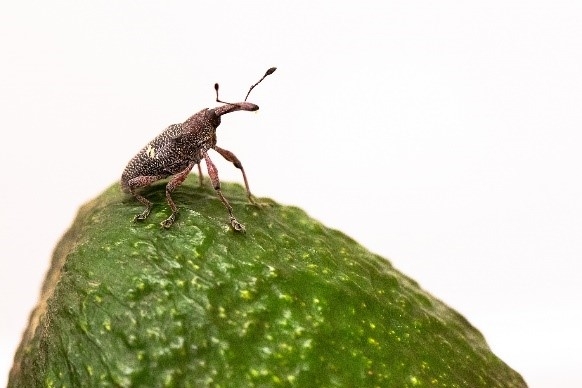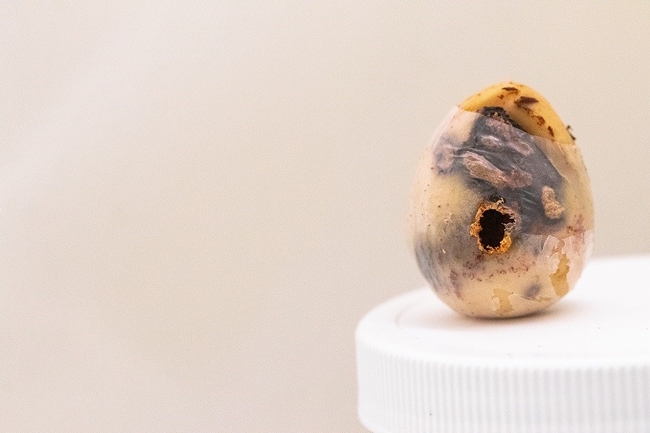Proactive Management of the Avocado Seed Weevil, Heilipus lauri
(Coleoptera: Curculionidae)
Mark S. Hoddle, Department of Entomology, University of California Riverside, CA 92521
Avocados are an iconic specialty crop in California that are grown by approximately 4,000 growers who farm around 50,000 bearing acres. The crop is worth ~$350 million per year. The `Hass' variety accounts for >90% of the fruit production in California.
The native range of avocados includes parts of Mexico, Central, and South America and in this area insect biodiversity is high as insects have co-evolved with this plant. In contrast, the biodiversity of the pest arthropod fauna associated with avocados in California is low, consisting primarily of about 4 invasive pest species of insects and mites that feed primarily on leaves, of which one, avocado thrips, Scirtothrips perseae, can cause damage to the skin of immature fruit (Hoddle 2006).
|
Heilipus lauri, the avocado seed weevil |
An Identifiable Invasion Threat – Heilipus spp. Weevils: Currently, California-grown avocados are free from specialist fruit feeding pests such as seed feeding weevils (e.g., Heilipus lauri.) and moths (e.g., Stenoma catenifer). Larvae of these pests bore into fruit to reach the seed. Establishment of these fruit feeding pests in California would cause significant disruption and threaten the long-term economic viability of this industry (Hoddle 2006).
Approximately eight species of Heilipus (there are ~85 species of weevils in this genus) are associated with avocados in the native range. The Heilipus complex attacking avocados fall into two groups:
(1) Fruit boring seed feeders (e.g., H. lauri [Mexico {native}, Colombia {invasive and introduced from Mexico in seeds used for root stocks [Castañeda-Vildózola, et al. 2017]}] H. pittieri [Costa Rica & Nicaragua] and H. trifasciatus[very limited range in Mexico]), and (2) Species that bore into stems and branches (e.g., H. albopictus [Mexico], H. apiatus [native to SE USA], H. cartagraphus [Brazil], H. elegans [Guatemala, Costa Rica, Panama, Colombia, Brazil], and H. rufipes [Brazil]).
Heilipus spp. are considered the most damaging pest complex associated with cultivated avocados (e.g., Hass and Fuerte) in the native range of this crop (Castañeda-Vildózola, et al. 2017; Luna et al. 2017).
Damage caused by Large Avocado Seed Weevil, Heilipus lauri: Adult H. lauri feed on small immature fruit and leaves, and young stems but don't reproduce on these structures (Caicedo et al. 2010). Female seed weevils lay eggs inside holes they drill into fruit using their long beak like snout or rostrum. Hass fruit ~4-5 cm in diameter are preferred for oviposition. Larvae that hatch from eggs deposited into oviposition chambers bore through the fruit pulp to the seed. Upon reaching the seed, larvae burrow
|
A hole in an avocado seed from which an adult H. lauri emerged |
into the seed to feed causing significant internal damage. Mature avocado seed weevil larvae pupate in the seed. Following pupation adults use their mandibles, located on the end of the rostrum, to chew a large circular exit hole to escape from the pupation chamber.
Internal feeding by larvae damages fruit, making it unmarketable, and in some instances heavy damage causes fruit to drop prematurely. In parts of Mexico, H. lauri is a significant pest of Hass avocados. Around 60% of Hass fruit have been reported as being damaged by H. lauri in unmanaged orchards in Morelos, Mexico (Medina 2005). In Colombia, damage levels in heavily managed Hass orchards range ~4-8% (Caicedo et al. 2010).
Control Options: Chemical control is difficult because larvae are protected within fruit (Caicedo et al. 2010). Cultural control (e.g., removal of infested fruit and branches) and trapping using black pyramidal interception traps (i.e., Tedders traps) that serendipitously catch motile weevils are ineffective for suppressing pest populations to non-damaging levels (Vallejo et al. 2014). The natural enemy fauna, especially the identity of parasitoids, attacking weevil eggs, larvae, and pupae is not well documented and natural enemy impacts need quantification (e.g., life table studies) (Caicedo et al. 2010; Castañeda-Vildózola, et al. 2017).
The Threat to California's Avocado Industry: Consequently, Heilipus spp. are listed by USDA-APHIS as avocado pests of high concern for countries that export avocado fruit (i.e., Hass) to the USA from areas where avocados and H. lauri are native (e.g., Mexico) or invasive (e.g., Colombia).
Initiation of a Proactive Mitigation Program for H. lauri: In response to the invasion threat posed by H. lauri to the California avocado industry a proactive mitigation project was initiated in February 2020. This program is supported financially by the California Department of Food and Agriculture's Office of Environmental Farming and Innovation Proactive Integrated Pest Management Solutions grant program.
A major focus of this research program is to identify the aggregation pheromone released by male weevils. If the pheromone can be identified and synthesized it will provide a powerful tool for incursion monitoring in California. Perhaps more importantly, the pheromone can be used in areas with H. lauri activity from which avocados are exported (e.g., parts of Mexico and Colombia) to the USA (especially California) to determine if these areas are free of H. lauri. In addition to detection and monitoring, the pheromone, if highly attractive, may have potency as a mass trapping tool that could be used to control weevils in export areas. This forward-leaning approach would deal with H. lauri at the source and would be an additional step in the pest management chain to further reduce accidental introductions of a serious avocado fruit pest into California.
With respect to the pheromone, this proactive management project has three main objectives: (1) to identify the aggregation pheromone released by male weevils. Progress has been made in Dr. Jocelyn Millar's lab in this respect. Two compounds (one major and one minor) have been identified. (2) Field tests in Mexico in 2021 will be conducted with cooperators with these two putative pheromone compounds to determine their attractiveness. (3) Once the pheromone component(s) is/(are) optimized for weevil attraction they will be deployed in one of seven different commercially available trap types used for catching weevils in agricultural settings. The goal of these field experiments is to identify the most efficacious trap design for use with the weevil pheromone.
So, please stay tuned, there will be a lot new and exciting findings to report on over the next two years!
References
Caicedo, L.R., E.V. Devia, T. Bacca, and A. Carabali. 2010. Daños ocasionados por el perforador del aguacate Heilipus lauri Boheman (Coleoptera: Curculionidae) en Tolima (Colombia). Revista Corpoica - Ciencia y Tecnología Agropecuaria 11: 129-136.
Castañeda-Vildózola, Á. et al. 2007. Genitalia de tres especies de Heilipus Germar (Coleoptera: Curculionidae) que dañan frutos de aguacate (Persea americana Mill) en México y Costa Rica. Neotropical Entomology 36: 914-918.
Castañeda-Vildózola, Á. et al. 2017. Sympatry of two species of Heilipus Germar, 1824 (Coleoptera: Curculionidae) infesting avocado (Persea americana Mill.) in Central Mexico. The Coleopterist's Bulletin 71: 361-363.
Hoddle, M.S. 2006. Lurkers on the threshold: Potential new fruit pests for California avocados. California Avocado Society Yearbook 89: 69-92.
Luna, A., V. López-Martínez, N. Bélgica Pérez-De la O, D. Jiménez-García, R.W. Jones, Á. Castañeda-Vildozola, and C. Ruiz-Montiel. 2017. Actual and potential distribution of five regulated avocado pests across Mexico, using the maximum entropy algorithm. Fla. Entomol. 100; 92-100.
Medina Q.F. 2005. Incidencia del barrenador grande del hueso del aguacate Heilipus lauri Boheman (Coleoptera: Curculionidae) en Tepoztlan, Morelos, Cuernavaca, Facultad de Ciencias Agropecuarias, Universidad Autónoma de Morelos. MS tesis, 39 pp.
Vallejo A.M.C., E. Arévalo, L.F. Torres, M.P. González, M.F.D. Niño. 2014. Especies Cuarentenarias del aguacate Hass en el Oriente de Antioquia y el Norte del Tolima en Colombia. Instituto Colombiano Agropecuario, ICA y Colciencias, 40pp.
Read more at: http://ceventura.ucanr.edu/Com_Ag/Subtropical/

